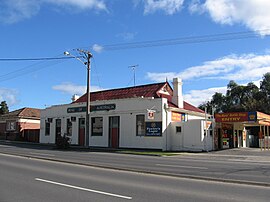Long Gully, Victoria
| Long Gully Bendigo, Victoria | |
|---|---|
 Rose of Australia Hotel | |
 Long Gully | |
| Coordinates | 36°44′S 144°15′E / 36.733°S 144.250°ECoordinates: 36°44′S 144°15′E / 36.733°S 144.250°E |
| Population | 3,383 (2016 census)[1] |
| Postcode(s) | 3550 |
| Location | 3 km (2 mi) NW of Bendigo |
| LGA(s) | City of Greater Bendigo |
| State electorate(s) | Bendigo West |
| Federal division(s) | Bendigo |
Long Gully is a suburb of the regional city of Bendigo in Victoria, Australia 3 kilometres (1.9 mi) north-west of the Bendigo central business district. At the 2016 census, Long Gully had a population of 3,383.[1]
Long Gully is a working-class suburb of Bendigo, featuring many older style fibro houses, punctuated by well-established light industry. The suburb is the location of the Bendigo RSL club, in Havilah Road.
Long Gully was heavily affected by the Black Saturday bushfires, causing one death.[2]
It is the birthplace of Dick Richards, GC (14 November 1894 – 8 May 1986). Richards was an Australian science teacher who joined Sir Ernest Shackleton's Imperial Trans-Antarctic Expedition in December 1914 as a physicist with the Ross Sea Party. He was 22 years old. He outlived all other members of the expedition and became the last survivor of the so-called "Heroic Age" of Antarctic exploration, dying at the age of 91 in 1986. His life-saving feats in the Antarctic are detailed in the book Shackleton's Heroes.
Sources[]
- McOrist, Wilson Shackleton's Heroes The Robson Press, an imprint of Biteback Publishing, London, 2015 ISBN 978-1-84954-815-1
References[]
| Wikimedia Commons has media related to Long Gully, Victoria. |
- ^ a b "2016 QuickStats Long Gully". Australian Bureau of Statistics. Retrieved 19 July 2018.
- ^ "Victoria under siege as fires rage across state". Herald Sun. 8 February 2009. Archived from the original on 8 February 2009. Retrieved 8 February 2009.
- Suburbs of Bendigo
- Bendigo
- Victoria (Australia) geography stubs
